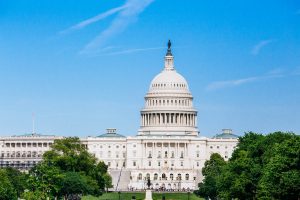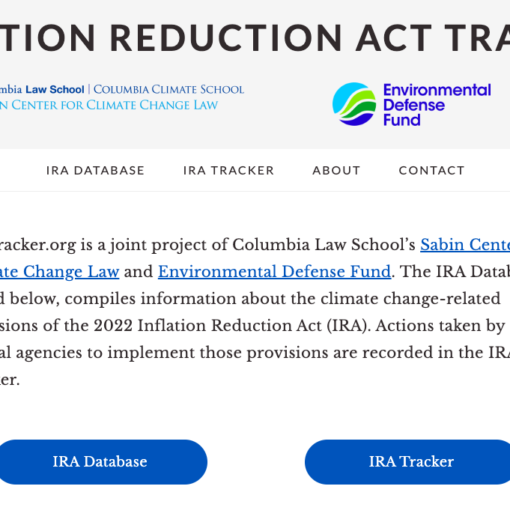By Michael Burger*

President Biden, National Climate Advisor Gina McCarthy and many others in the administration leadership have touted its highly ambitious, whole-government approach to taking the climate crisis. In the administration’s first three months, we have already seen this begin to take shape. Yet, even as global leaders convene for President Biden’s Earth Day climate summit to make major announcements about new climate pledges, the international community, still recovering from four years of Donald Trump’s climate denial and disengagement, has begun to push back, at least in places, against the idea of U.S. leadership in the climate policy space. The question they raise is a good one: Can Biden’s climate policies last, even if an anti-regulation, anti-science, anti-environment president once again sits in the White House?
It won’t be easy. Presidents have powerful tools to pursue their policies, including the power to reverse the policies of their predecessors – at least to some extent. President Trump’s rollbacks were maximally extreme, but there is always some change when the opposition party takes control. What’s more, big ticket regulation is subject to judicial review. The U.S. courts of appeals have been stacked with Trump appointees recommended and advanced by the anti-regulatory Federalist Society, and the conservative majority on the Supreme Court has a frank and vocal resistance to expansive use of federal agency authority. Judicial skepticism of agency rulemaking may be at an all-time high.
Nobody wants a radical reshuffling of rules and regulations after every election. These pendulum swings can be disruptive for business and confusing for the public, and they make it hard to make real, sustained progress toward achieving policy goals. Moreover, the principles that guide judicial review favor stability, not chaos. Given these realities, there are any number of things the Biden team can do—even in the absence of new Congressional legislation, and beyond what can be achieved through the budget reconciliation process—to make its ambitious, across-the-board climate plan stick. Here are a few:
First, the Biden team needs to continue to move fast to lock in rules that require investments in infrastructure or pollution control equipment that will be difficult to undo. Creating these facts on the ground engenders “reliance interests,” which reflect the investments and decisions made based on existing rules; these reliance interests are perhaps the most potent reason why courts resist agency policy reversals, and one of the main reasons courts require agencies to more fully justify them. Agencies may be able to speed things up, at least in some cases, by issuing “direct final rules” for noncontroversial regulations, or by engaging in “negotiated rulemaking” for more complex ones. Direct final rules simply state that a rule will take effect on a date certain, unless there are significant adverse comments. Negotiated rulemaking brings stakeholders to the table to help craft the rule, which can stave off industry and political opposition. (To be fair, negotiated rulemakings can take a lot of time, too.)
In most instances, though the agencies will have to go through the more familiar, standard procedures. And when they do, they need to do it right. This means using the full notice-and-comment rulemaking process, rather than relying on less formalized policy statements or guidance. A future administration would then need to use notice and comment to undo such a rule, which takes time and resources. It means not cutting procedural corners – a point that may seem trite, but is exactly what the Trump administration neglected to do, with court losses piling up as a result. It means building a strong record based on public health data, technology assessments, and economic analysis/modeling, along with evidence of industry practices and other relevant information, so that it will hold up to judicial scrutiny and make it difficult for a new administration to contradict without building an equally robust record. It may also mean avoiding “adventurous” statutory interpretations – particularly interpretations seeking to expand agency authority into new, previously unregulated areas. Agencies should push hard on ambitious standards, but color within the lines of their legal authority.
Second, agencies may also include some defensive measures in their new rules to ensure key purposes can be pursued even if some part of the rule falls in court. Such measures include “severability clauses” that specify which provisions are severable from the rest of the rule, so they can be treated separately, and “fallback provisions,” which may reflect modestly less ambitious or less stringent approaches to regulation. Agencies will rightfully be reluctant to do this, because it could signal weakness or doubt, but in the face of the nation’s current slate of judges, it bears consideration.
Third, the agencies need to push for, maximize and then leverage industry support, including support from obvious allies in the renewable energy sector, insurance/reinsurance, and elsewhere. Many companies have talked a big game. But it is time to make good on the promise of corporate leadership on climate change. This means supporting rapid administrative and legislative action, and large-scale investments in Paris-aligned businesses and operations. It means not joining lawsuits brought by Republican attorneys general against Biden administration rules, and it means resigning from industry associations and organizations that do. We are at an inflection point in the negotiations between potential winners and losers in a Paris-aligned economy. The administration is at the crux of things, and it needs to pull all the levers available to bring regulated entities on board. This will create those reliance interests mentioned above, and will create a tougher, more complex fabric for future administrations, and the courts, to try to tear apart.
Fourth, the Biden administration can mainstream climate change throughout its international trade and investment policies. This is a critical piece of the puzzle. The U.S. needs to protect its own regulations from legal challenges from foreign companies under trade and investment law. At the same time, the U.S. needs to reduce U.S. corporate interests in disrupting climate action in other countries. (Remember, TransCanada sued the United States over the 2016 withdrawal of the presidential permit for the Keystone Pipeline. More recently, the German utility RWE brought an investor-state arbitration to ICSID over the Netherlands’ coal phaseout.) Among other options available: To the extent investment agreements do not already preference climate-friendly or climate-forward investments they may be revised to include specific preferences, incentives and protections for those investments. At the WTO, the administration could advocate for adoption of a climate waiver, that would accommodate the industrial policies necessary to kick the clean energy economy into the next gear. And in negotiating new or modified bilateral and regional trade agreements the administration can seek to include provisions that expressly favor cooperation on climate regulation and climate friendly trade, and perhaps even assure the continuation of existing pro-renewable policies.
There is much more to be said about building climate rules that will stand the test of time. And the administration very clearly has this in view. These are just a few key touchpoints, worthy of some consideration, as the new climate agenda gets revved up and ready to roll.
*I would like to thank Professor Jody Freeman, whose thinking and correspondence helped inform this blog post.
Tiffany is the Communications Associate at the Sabin Center for Climate Change Law.





